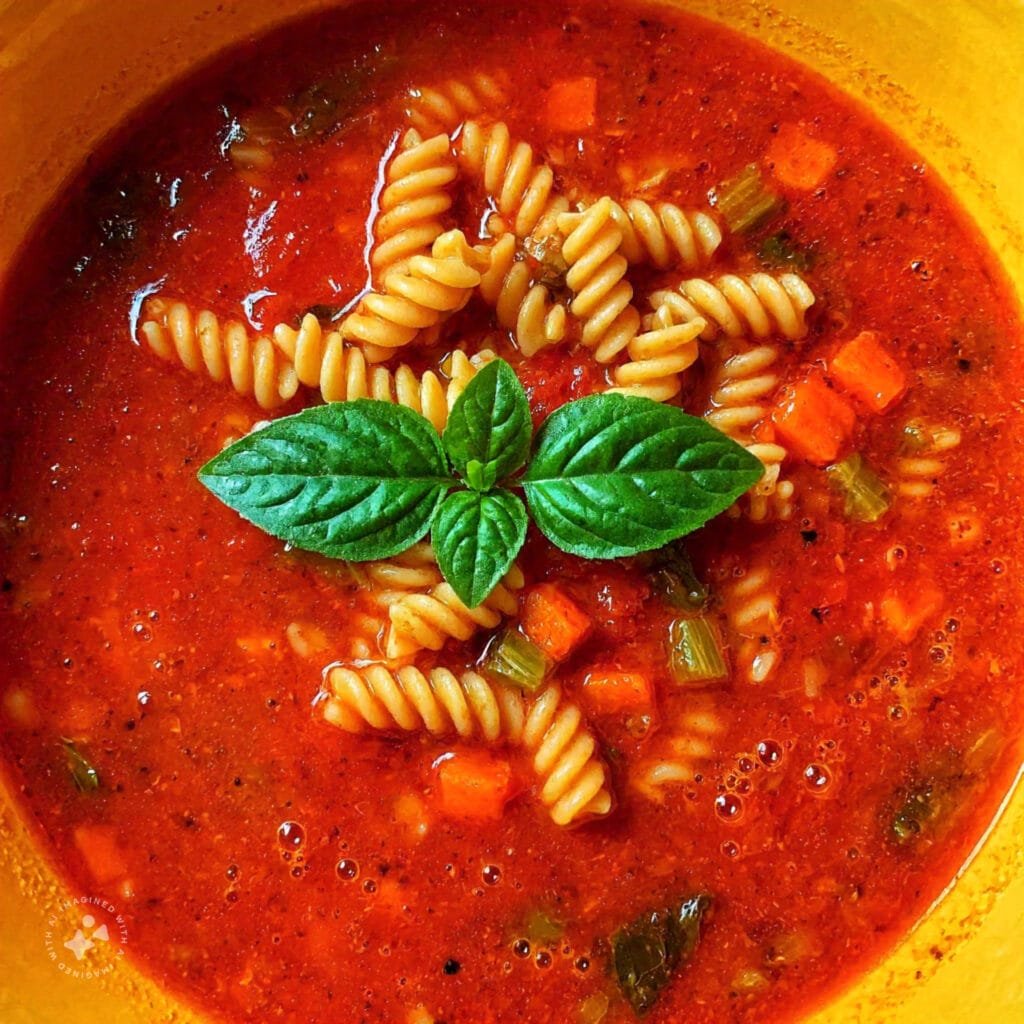Table of Contents
Introduction to Ditali and Ditalini Pasta
Have you ever wondered, what is the difference between ditali and ditalini pasta? These two small pasta shapes may look alike, but they bring unique textures and flavors to Italian cuisine. While both are tubular and tiny, their differences shine when used in the right recipes. In this guide, we’ll explore the origins, uses, and culinary secrets of ditali and ditalini pasta, helping you choose the perfect pasta for your next meal.
Italian cuisine, famous for its diversity, uses pasta as a canvas for culinary creativity. Each pasta shape has a story, a purpose, and a tradition attached to it. While ditali and ditalini might look like siblings in the pasta family, their subtle differences make all the difference when it comes to cooking.
Origins of Ditali and Ditalini Pasta
Ditali and ditalini have their roots in the heart of Italy, where pasta isn’t just food—it’s an emotion. The names themselves are a clue: “ditali” translates to “thimbles” in Italian, and “ditalini” means “little thimbles.” These names hint at their petite, tube-like shapes, perfect for holding onto sauces, broths, and spices.
Ditali was traditionally used in southern Italy, especially in hearty dishes meant to sustain families through tough times. On the other hand, ditalini became a favorite in northern Italian soups, where its smaller size made it a charming addition to broths and minestrone.
Why Italian Cuisine Celebrates Pasta Shapes
Have you ever wondered why Italians have over 350 pasta shapes? It’s all about harmony. Each shape is designed to work with a specific sauce or cooking method. Ditali and ditalini embody this principle beautifully. Their tubular forms make them champions at absorbing flavor, proving that size doesn’t always dictate greatness.
As a famous Italian chef once said:
“Pasta shapes are like the notes in a melody—they bring the dish to life when combined with the right ingredients.”
Understanding Ditali Pasta
Shape, Size, and Texture of Ditali
Ditali pasta is short, cylindrical, and slightly thick, making it sturdier than its smaller counterpart. Imagine tiny tubes that can stand up to rich, chunky sauces. Its firm texture means it retains its shape well, even in baked dishes or when tossed in a hearty ragu.
Common Uses of Ditali Pasta in Recipes
Ditali shines in recipes where you need a pasta that can hold its ground. Here’s where it steals the show:
- Soups: Think pasta e fagioli (pasta and bean soup) where ditali acts like little flavor sponges.
- Salads: Toss them in a cold pasta salad with olives, cherry tomatoes, and a tangy vinaigrette.
- Baked Dishes: Picture cheesy casseroles where each tube traps gooey cheese and bits of sauce.
The versatility of ditali makes it a favorite for home cooks and chefs alike.
Traditional Ditali Dishes in Italian Cuisine
If you’ve ever savored a bowl of pasta e ceci (pasta with chickpeas), you’ve probably encountered ditali. This pasta has been a staple in rustic Italian cooking for centuries. It’s all about using simple ingredients to create something extraordinary.
Fun fact: Ditali was once considered a “poor man’s pasta” because it paired beautifully with inexpensive ingredients like beans and lentils. Yet, its humble beginnings didn’t stop it from becoming a beloved classic.
Exploring Ditalini Pasta
The Unique Characteristics of Ditalini Pasta
Ditalini, as the name suggests, is essentially a smaller version of ditali. It’s delicate, tiny, and perfectly sized for lighter dishes. Imagine mini tubes of pasta that can float in a spoonful of soup. Its size makes it a favorite for recipes where subtlety matters.

Popular Ditalini Pasta Recipes
Ditalini often takes center stage in soups, salads, and even baby-friendly dishes. Here are a few ideas:
- Minestrone Soup: Its small size makes it blend seamlessly with veggies and broth.
- Cold Pasta Salads: Ditalini pairs wonderfully with creamy dressings and diced veggies.
- Kid-Friendly Meals: Its tiny size is perfect for little hands and picky eaters.
Isn’t it amazing how such a small pasta can bring so much joy to a meal?
The Role of Ditalini in Soups and Salads
Ditalini’s primary role is to enhance the texture of a dish. In soups, it adds a bite without overwhelming the broth. In salads, it acts as a charming contrast to crunchy vegetables.
Think of ditalini as the supporting actor in a movie—it doesn’t steal the spotlight, but the dish wouldn’t be the same without it.
Key Differences Between Ditali and Ditalini Pasta
Comparative Shape and Size Analysis
Let’s break it down. Ditali is larger and sturdier, ideal for heartier recipes. Ditalini, on the other hand, is smaller and more delicate, perfect for lighter dishes. It’s like comparing a hammer to a paintbrush—each has its purpose.
Variations in Culinary Applications
While ditali can handle heavy sauces and baked dishes, ditalini thrives in brothy soups and salads. Choosing the right pasta can make or break your recipe.
Texture and Mouthfeel: A Detailed Comparison
The thicker walls of ditali give it a firmer bite, while ditalini’s thinner structure offers a softer, more melt-in-your-mouth experience. Your choice depends on whether you want a chewy texture or something more delicate.
“The beauty of pasta lies in its adaptability. Whether it’s ditali or ditalini, the key is pairing it with the right ingredients to create a symphony of flavors.” 🎵
Nutritional Insights: Ditali vs. Ditalini Pasta
Which One Is Healthier?
When it comes to nutrition, ditali and ditalini are virtually identical in terms of calories, carbs, and protein. Both are made from durum wheat semolina, providing a steady release of energy and a good dose of fiber (if you opt for whole grain varieties).
The real nutritional differences come from how you prepare them. If you’re using ditali in a cheesy baked dish, it’s likely to pack more calories than ditalini floating in a light vegetable soup. In other words, the healthiness of these pastas isn’t about the shape—it’s about the company they keep!
Tips for Choosing the Right Pasta for Your Meal
Feeling overwhelmed by all the pasta choices? Don’t sweat it. Choosing between ditali and ditalini boils down to the texture and purpose of your dish.
- For Hearty Soups: Go with ditalini; its smaller size blends seamlessly.
- For Casseroles: Ditali’s sturdiness makes it the champion here.
- For Light Salads: Ditalini’s tiny shape works better in cold pasta dishes.
A simple rule of thumb? The chunkier the ingredients, the bigger the pasta you should use.
Common Problems When Using Ditali and Ditalini Pasta
Overcooking: How It Affects Both Pastas
Have you ever ended up with mushy pasta? Overcooking can be a real enemy, especially for ditalini. Since it’s smaller and thinner, it cooks faster, leaving less room for error. Overcooked ditalini tends to lose its shape and turn into a soggy mess.
Ditali, with its thicker walls, is a bit more forgiving but still benefits from precise timing. Always follow the package instructions and test your pasta a minute or two before it’s “done” to ensure the perfect al dente texture.
Selecting the Wrong Shape for a Recipe
Choosing the wrong pasta can throw off the balance of a dish. Imagine using ditalini in a chunky ragu or ditali in a delicate broth. The mismatch can make the dish feel awkward and uncoordinated, like wearing flip-flops to a formal dinner.
Pro tip: When in doubt, think about the texture and size of your other ingredients. The goal is to create harmony on the plate.
How to Use Ditali and Ditalini Pasta Like a Pro
Expert Tips for Cooking Perfect Pasta
Cooking pasta may seem straightforward, but mastering it is an art. Here’s how to get it just right:
- Use Plenty of Water: A large pot of water ensures the pasta cooks evenly and doesn’t stick together.
- Salt Generously: Your water should taste like the sea. This is the only chance to season the pasta itself.
- Don’t Overcrowd: Too much pasta in one pot can cause uneven cooking.
- Reserve Pasta Water: That starchy water is liquid gold for binding sauces.
Cooking pasta is like brewing the perfect cup of coffee—it’s all about balance and timing.
Pairing Pastas with the Right Sauces
Choosing the right sauce can elevate your dish from good to unforgettable. Ditali’s sturdiness pairs beautifully with chunky, robust sauces like meat ragu or vegetable stews. Ditalini, on the other hand, thrives in lighter, broth-based dishes or creamy salads.
As the Italians say:
“The sauce chooses the pasta, not the other way around.” 🇮🇹
Think of ditali as a trusty workhorse and ditalini as a delicate artist—each has its strengths depending on the recipe.
How to Use Ditali and Ditalini Pasta Like a Pro
Creative Recipe Ideas for Ditali and Ditalini Pasta
Feeling inspired to cook with ditali or ditalini? Here are some creative recipe ideas to bring these pasta shapes to life in your kitchen.
- Ditali Bolognese Bake: Layer cooked ditali with a hearty meat sauce, mozzarella, and parmesan. Bake until golden and bubbly. It’s like lasagna but with a fun twist.
- Lemon Herb Ditalini Salad: Toss ditalini with fresh parsley, dill, lemon zest, and a drizzle of olive oil. Add feta and cherry tomatoes for a refreshing side dish.
- Creamy Ditali Mushroom Skillet: Sauté mushrooms with garlic, butter, and cream, then stir in cooked ditali for a rich, comforting meal.
- Classic Minestrone with Ditalini: Load up a pot with vegetables, beans, and a light tomato broth, then finish it with perfectly cooked ditalini for a hearty soup.
Storing and Reheating Tips for Ditali and Ditalini Pasta
We’ve all been there—leftover pasta that turns into a sticky, clumpy mess. Here’s how to store and reheat ditali and ditalini like a pro:
- Store Separately: If possible, keep pasta and sauce in separate containers. This prevents the pasta from soaking up all the sauce and becoming soggy.
- Toss with Oil: Before storing, lightly toss the cooked pasta with olive oil to prevent sticking.
- Reheat Gently: Reheat pasta on the stovetop with a splash of water or broth to revive its texture. Microwaving works, but it’s not ideal for preserving the pasta’s quality.
Did you know? Adding a bit of grated cheese during reheating can help bring your leftovers back to life.
Elevating Simple Dishes with Ditali and Ditalini
Sometimes, less is more. Both ditali and ditalini can turn simple ingredients into culinary masterpieces.
- Garlic and Olive Oil Ditali: Sauté minced garlic in olive oil, toss with cooked ditali, and finish with a sprinkle of red pepper flakes and parmesan.
- Ditalini with Butter and Herbs: Melt butter, toss in some fresh herbs like basil or parsley, and coat your ditalini for a quick and delicious meal.
It’s proof that with the right pasta, even the simplest combinations can feel like a gourmet treat.
Comparing Ditali and Ditalini Pasta in Global Cuisines
Beyond Italian Borders
While ditali and ditalini are Italian by birth, their versatility has made them popular in global cuisines. In the United States, for example, ditalini is a common choice in macaroni salads. In Middle Eastern cooking, these pasta shapes are sometimes added to stews or even used as a rice substitute in pilaf-style dishes.
This adaptability speaks to the universal appeal of pasta. No matter where you go, you’ll find a unique spin on these Italian classics.
How Different Cultures Customize Ditali and Ditalini
Pasta lovers around the world have their own ways of making these shapes shine:
- In Mexico: Ditalini is sometimes used in soups with a spicy tomato broth, garnished with avocado and cilantro.
- In Greece: You might find ditali in baked casseroles with ground lamb, tomatoes, and a hint of cinnamon.
- In India: Small pasta shapes like ditalini are occasionally cooked in creamy, spiced lentil soups for added texture.
These interpretations show how pasta transcends borders, adapting to local tastes and traditions.
Why Choosing the Right Pasta Shape Matters
The Science of Pasta and Sauce Pairing
Why does choosing the right pasta shape matter? It’s all about texture and how the pasta interacts with the other elements in the dish.
Ditali’s larger size and sturdier structure are perfect for holding chunky sauces, while ditalini’s smaller, more delicate shape blends seamlessly into broths and light salads. Choosing the right pasta is like picking the perfect tool for a job—it ensures every bite is harmonious.
Practical Tips for Pasta Perfection
Not sure where to start? Here are some practical tips to ensure your pasta dishes shine:
- Test Cook Times: Pasta brands can vary, so always test for doneness a minute or two before the suggested time.
- Mix It Up: Don’t be afraid to experiment with ditali or ditalini in unexpected dishes like stir-fries or even desserts (think sweet pasta pudding!).
- Embrace Creativity: Pasta is your blank canvas—play with sauces, toppings, and seasonings to make each dish unique.
Final Thoughts on Ditali and Ditalini Pasta
When it comes to ditali and ditalini, there’s no definitive “better” option. Each has its own strengths, and the best choice depends on the dish you’re preparing. Whether you’re creating a hearty casserole, a refreshing salad, or a comforting bowl of soup, these small yet mighty pasta shapes bring something special to the table.
As with any cooking adventure, the key is to have fun, experiment, and enjoy the process. After all, food is about connection—both to tradition and to the people we share it with.
FAQs
What are ditali and ditalini made of?
Both are typically made from durum wheat semolina, though whole-grain and gluten-free varieties are also available.
Can I substitute ditali for ditalini?
Yes, but it depends on the dish. Ditali works better in heavier recipes, while ditalini shines in soups and lighter dishes.
Do ditali and ditalini cook for the same amount of time?
No. Ditalini, being smaller, usually cooks faster than ditali. Always check the package instructions for best results.
Which pasta is better for soups?
Ditalini is ideal for soups because of its smaller size, which blends well with broth and other ingredients.
Is one pasta healthier than the other?
Nutritionally, they’re nearly identical. The healthiness depends on how you prepare them and the ingredients you use.
Why are there so many pasta shapes in Italian cuisine?
Each shape is designed to complement specific sauces or cooking methods, ensuring the perfect balance of flavor and texture.
Conclusion: Choosing Between Ditali and Ditalini Pasta
So, what’s the verdict? While ditali and ditalini may look like close cousins, their subtle differences make each one special. Ditali is the go-to for hearty, robust dishes that need a pasta with presence, while ditalini’s delicate size makes it perfect for soups, salads, and lighter fare.
At the end of the day, the best choice comes down to your recipe and personal preference. After all, cooking is as much about creativity as it is about tradition.
You might also like Ditalini Pasta Recipes: A Complete Guide to Delightful Dishes.





